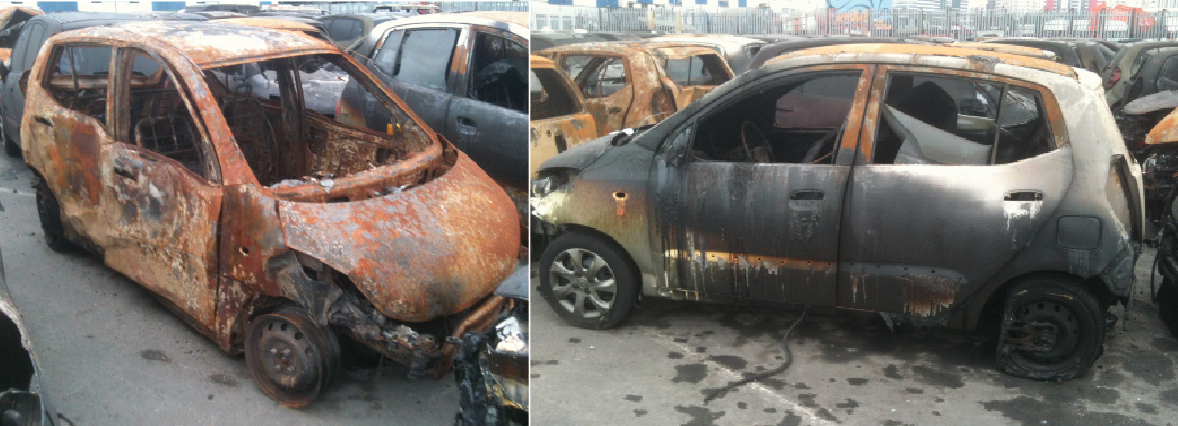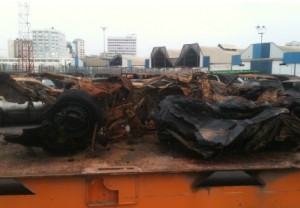Realities of a risky business
OEMs would love to reduce their insurance premiums, but with catastrophic damage more frequent, they may have to risk their balance sheets to achieve this
When Superstorm Sandy made landfall on the eastern seaboard of the US in October 2012, hurricane-force high winds were just one problem. Another was the enormous storm surge which brought extensive flooding in its wake. Along with the massive loss of homes and lives, a quarter of a million vehicles were flooded, mostly to be written-off by insurers. Even before the storm hit, insurers began renting vast holding areas to store storm-damaged cars: thousands, for instance, were stored on the runways at Calverton Executive Airpark in Calverton, New York.
However, as states in the hurricane’s path began making preparations for its arrival – cancelling flights, closing schools and businesses, and stocking up on emergency supplies – something odd was taking place. Logistics providers were still delivering vehicles to car dealers’ lots and storage compounds already known to be in the path of destruction.
“There were trainloads of vehicles heading for coastal facilities right in the eye of Hurricane Sandy, being carried by Norfolk Southern, Canadian Pacific and CSX, despite there being alternative facilities 50 miles (80km) or so away, outside the flood danger zone,” recalls Marna Short, general manager for inspections at logistics service provider Vascor. “A diversion would have cost a little more, but the vehicles wouldn’t have been totalled.”
The lack of diversion from such a storm, adds Short, isn’t an isolated instance. Across the finished vehicle supply chain, she suggests, vehicles are often put at risk unnecessarily. Yet because the vehicles in question are insured, the risk is deemed acceptable, even when the danger is almost unavoidable.
"Falling premium inflows lead to fewer investment opportunities and reduced yields, so it’s not necessarily in insurers’ interest to reduce claims and damage" - Matt Holmes, Sevatas
“Across North America, I know of no instances of facilities being flooded that haven’t already been flooded in the past,” she says. “But these facilities are still in operation and every year, when floods are likely, there’s a scramble to temporarily move vehicles out of them – all of which adds cost. But there never seems to be the return on investment and business case for moving the facility itself away from flood danger and onto higher ground.”
The complex world of insurance
This is just one of a number of issues associated with insurance and damage limitation facing the auto industry. It would seem that there may be a prize worth having on offer: if changes in logistics practices resulted in reduced risk, then surely this should feed into lower insurance premiums. Not so fast. In the world of insurance, things aren’t that simple.
Consider the fact that while there’s already been a widely reported reduction of in-transit damage rates, premiums have stayed stubbornly high. Precise figures vary bycarmaker, but one authoritative industry source describes a reduction over the past six or seven years from an average of 3% damage to an average of 1.5-2% – a rough halving, in other words, and testimony to the industry’s focus on better handling and damage reduction. So why hasn’t there been a matching reduction in premiums?
To start with, points out Matt Holmes, a director at claims agent and risk adviser Sevatas, insurance isn’t an especially profitable line of business. Insurers, he explains, make most of their profit not from the difference between the premiums they take in and the claims they pay out, but from investing those premiums in the stock market.
In other words, what’s at work is a gearing or leverage effect: insurers ‘borrow’ premium payments at an advantageous rate – determined by the level of payouts that they make – and then invest these premiums for still-higher returns. As with any financial gearing or leverage, a reduction in base income has an amplified – and unwanted – impact on achieved returns.“Falling premium inflows lead to fewer investment opportunities and reduced yields, so it’s not necessarily in insurers’ interest to reduce claims and damage,” says Holmes.
Moreover, adds Paul Bromley, director for new vehicle operations at port operator and vehicle logistics specialist Paragon Vehicle Services, which handles UK port operations for Fiat, General Motors, Toyota, and Mitsubishi, the focus of the finished vehicle logistics industry has itself changed in recent years.“There’s a sense that insurance people don’t have an interest in reducing damage, because at present levels, damage levels are built into the pricing,” he observes. “Twenty years ago, if you phoned someone up and said that you were concerned about damage levels, people would jump on a plane. These days, operations are too lean: there aren’t the people and agendas are stretched.”
Reducing the minor, but more of the major
Also to blame for the elevated level of premiums at present is a concern that while the risk of in-transit damage might be reducing, the reduction is more than compensated for by the impact of other sources of risk moving in the opposite direction.
“Yes, vehicle damage rates have been reducing for transit damage,” points out an executive of one of the world’s largest specialist automotive claims handling firms, speaking on condition of anonymity. “However, vehicles in open storage have experienced increasing real claims – that’s real claims and not perceived claims – from flood, earthquake, tsunami, hail, wind and radioactive fallout.
“The rates on offer in the marketplace do not even begin to compensate insurers for sustained losses in these areas,” the executive continues. “The insurance market has lost its appetite for insuring automobiles in open storage, leaving carmakers and their insurers in difficult circumstances – and the discussions are not very promising.”
Ironically, points out Holmes, the automotive industry increasingly tends to focus on just those very losses as the mainstay of their insurance requirements. [sam_ad id=6 codes='true']
“Japanese auto manufacturers tend to have low, or zero, ‘deductibles’ – the amount that they themselves must pay in respect of each claim – and so all damage is passed to insurers,” he observes. “But that’s not a universal model, and other auto manufacturers have much higher self-insured arrangements, which means that only catastrophic losses are passed to insurers. Indeed, one of our clients has a deductible so large that you’d have to have a Boeing 747 hit a vehicle compound before there was any risk of a claim. Put another way, the biggest-ever claim we’ve seen for hail damage was $6m – and this client’s deductible is higher than that, meaning that a comparable claim would be entirely uninsured.”
In general, he says, a strategy of self-insurance makes growing sense. “Companies such as automakers with huge balance sheets and multi-billion dollar revenues don’t need insurance for low-level damage claims, so why insure them? Day-to-day damage losses can easily be supported by the business, with some costs recovered from the logistics suppliers,” he points out. “In practice, automakers who insure low-level damage are not really transferring risk, which is what insurance is all about. Instead, they’re purchasing claims management and loss-prevention services, but these services are also available independently of insurers through claims management companies such as ours.”
The largest cogs in the world’s finished vehicle supply chains have the muscle to engage with insurers and be heard. If you’re a Toyota or a Ford, or a global shipping line, then there’s a dialogue to be had and negotiations to be conducted. But for smaller cogs, that dialogue can be distinctly one-sided, say experts.
At seven-location North American port processor of Global Auto Processing Services, for instance, “our industry kind of gets lost,” says Don Asdell. “The insurers don’t really understand the industry that we’re in, and the risks that we face. We’re fortunate to have a good relationship with our insurance company’s local representative, who fights our corner, but we don’t really fit into any of their boxes and they don’t understand what we do.”
The structure of the industry itself adds to the confusion, he explains. “One of the challenges we face is that when there’s an incident, it can be difficult explaining that we don’t have ownership of the asset in question. We’re between the manufacturer and the dealer: we’re responsible for the vehicle, but we don’t have title to it.”
Consequently, says Scott Naz, managing partner at logistics brokers MetroGistics, ‘self-help’ is the best way of cutting insurance costs. “We use the Department of Transportation database to monitor all 3,500 of the carriers we use, with a small carrier management team looking at it every day in order to look for suspicious status changes or safety issues. Plus, every night we check that the carriers we’re using carry valid insurance, in the right amount and with the right liability,” he explains.
“Also, we rate every single one of our own interactions with a carrier, just as consumers do with eBay transactions,” Naz continues. “Were their communications good? Were there any issues? Were there any exceptions – not just damage, but not meeting the pick-up? Can we get hold of them if we need to, or are we forced to leave messages? Incidents don’t happen very often, but we’re pretty sure that if we didn’t do the things that we do, then there would be more incidents, and that would bump up the insurance rates that we pay.”
Consider the catastrophes

For higher-value damage or losses, insurance is much more worthwhile and makes more sense, observes Holmes. Consider, for instance, the Baltic Ace, an eight-deck ro-ro car carrier that collided with a container ship in the North Sea in December 2012, sinking within 15 minutes. Eleven crew members died and the cargo of 1,400 Mitsubishi cars heading for the Russian market, valued at $50m, was a total loss.
Such incidents are more frequent than might be imagined. Take the Tricolor, which sank in similar circumstances some 17 miles off the French coast in 2002, taking 2,871 premium-end vehicles from BMW, Volvo and Saab to the bottom. Or the Cougar Ace, which rolled over to an almost 90-degree angle during a ballast transfer operation. On board were 4,703 Mazda vehicles worth $117m, all of which were scrapped after a salvage operation. More recently, sources report that a fire which started on board a ro-ro vessel after a deck lifter came loose resulted in more than Ä40m ($54m) worth of damage to vehicles alone (see photos of burnt vehicles).
Higher-value risks are not only found at sea, of course. Hail causes considerable damage and results in severe losses for carmakers and insurers. In July 2013, for instance, a hailstorm bombarded compounds at Volkswagen’s Wolfsburg site in southern Germany with hailstones reaching the size of golf balls, causing damage reckoned to amount to millions of euros to some 17,000 vehicles – delaying shipments and leaving many vehicles with broken windshields, dents, dings and scratches. This wasn’t the first time that Volkswagen had been hit by damage on this scale: back in 2008, it was badly affected by a hailstorm that hit 30,000 vehicles parked in the open at the German port of Emden.
Such incidents, together with headline disasters like Sandy, the Japanese tsunami, the flooding in Thailand and a spate of vicious hailstorms across Europe and North America, have made insurers nervous, agrees Willem de Lange, managing director of automotive claims handling specialist TES Automotive.
“After a period of years without significant incidents, these large, unpredictable losses are causing concern and a sense that the good days might be over,” he notes. “Previously, we had a situation where there were lots of small incidents, associated with lots of small premiums. Now, it’s not levels of day-to-day damage that are being used to set insurance premiums: instead, it is concerns about the possibility of being exposed to significant loss.”
De Lange and others agree that for premiums to fall, the automotive industry must take meaningful steps to reduce that possibility of significant loss. However, that won’t be easy – not least, because the process won’t be free.
Incentives are part of the reason why the vehicle logistics industry continues to make progress in reducing everyday damage across road transport, rail and at sea. One programme, for instance, has helped bring a reduction in so-called ‘Class 2’ damage (where damaged vehicles must be sold at auction, rather than repaired) that is in excess of 50%, explains Don Asdell, president and chief executive of Global Auto Processing Services. Under this action, when adverse weather is expected, areas of compounds known to be susceptible to flooding are cleared of vehicles.
The company is also piloting a programme of no longer hiring 18-19 year olds, but instead requiring people to have seven years driving experience.
“We’re reducing our hiring pool, but seeing as a result a reduction in the number of accidents we have,” he says. “Most accidents occur where people are fatigued or not paying attention and we’re finding that older drivers are safer drivers.”
Compared to the impact on damage rates, such initiatives are largely cost-free, but that won’t be the case with initiatives aimed at achieving a reduction in the possibility of catastrophic loss, warn those close to the issue. Sevatas’s Holmes, for instance, points out that carmakers routinely single-source their deep-sea freight lanes, aiming to achieve the lowest-possible shipping cost per vehicle.
Abandoning this practice in favour of multi-sourcing would almost inevitably see per-vehicle shipping rates go up, but it would also spread a manufacturer’s vehicle movements across multiple vessels, reducing the number of vehicles that an insurer had exposure to on a given ship. The result would be a reduction in the insurer’s liability exposure in the event of an incident such as a sinking. “It’s a trade-off – increased sea rates, versus lower premiums,” sums up Holmes.
De Lange agrees, stressing that the overall objective shouldn’t just be reduced premiums, but a position of genuinely lower risk resulting in lower levels of damage
and loss.

“A focus on reducing insurance premiums in isolation is missing the point,” he insists. “What’s required is a look at risk from the outset; when making decisions about hail nets, setting up facilities, or choosing terminal locations. At each stage, there are options to reduce risk, but they need balancing against the extra cost that is incurred.”
Such a ‘total supply chain’ viewpoint may require carmakers and logistics providers to be more transparent about auditing and sharing data on risk and damage, adds Paragon’s Bromley.
“Despite progress, there are still too many opportunities for damage and theft,” he points out. “We know that if we’re transhipping through certain Italian ports, we’ll incur loss of parts – toolkits, torches, GPS memory cards and so on. Vehicle manufacturers need to be more aggressive about auditing supply chains, looking at damage statistics, and assessing all the risks.”
Paths to reducing premiums
Bromley adds that carmakers need to be better at identifying best practice in risk reduction and damage reduction, and demanding improvement where necessary. “Just last year, I told the managing director of a shipping line that our vehicle damage rates with his line were over 5%, a figure to which he’d been oblivious,” he says. “I asked him if he wasn’t embarrassed by that? This year, the damage rate has started to come down.”
Cutting claims processing costs is another possibility, points out Sjors Bosvelt, general manager at Rotterdam terminal operator Broekman Car Handling. “As an industry, we have to digitise the entire claim procedure and make sure we use unified damage codes accepted by the entire industry, so that we’re all speaking the same language and avoiding excessive administrative cost,” he says. “We need a broad discussion between all stakeholders as to how to decrease unnecessary insurance cost, by working more efficiently, uniformly and more digitally. We have apps on our phones for just about everything, except damage claims handling.”
Such approaches need to be applied over the long term, but Matt Holmes suggests that there may be some quick wins out there as well. One approach is for OEMs to agree to a higher deductible – accepting liability for, say, the first €1,000 of any claim, as opposed to the first €100. This would then see a reduction in premiums.
Another option, he adds, is for carmakers to move to what’s called a ‘franchise’ model. “Moving from a low deductible to a higher franchise of, say, €500 would mean that a claim of €499 would be uninsured, but that a claim of €505 meant that the insurer pays €505. The insurer pays in full once the franchise level has been breached,” he says.
More imaginatively still, he adds, there’s also an ‘annual aggregate deductible’ model to consider. Under this system, carmakers decide upon a maximum self-insured level that is applicable for a whole year of losses, rather than making individual claims.
“An annual aggregate deductible of €500,000 means that the insurer doesn’t pay a penny until the client has aggregated losses of that reach €500,000,” explains Holmes. “After that, all claims are paid in full. It’s a good way to budget maximum exposure for the automotive manufacturer – namely, their exposure is limited to €500,000 – but one that also reduce insurers’ exposure, as well.”
There are, then, some potential steps to lowering costs: agree uniform approaches; take long-term steps to reduce risk; and be prepared to take a little more financial risk on the balance sheet. If the automotive industry does these things, those in the know believe insurance costs should fall. The question is whether the patient will take the medicine and trade some upfront costs for potential savings. There is certainly no guarantee of that.





